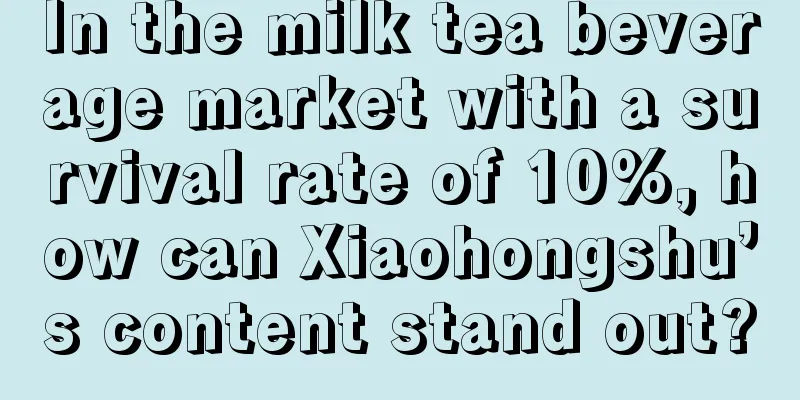With low prices across the board, are brands meaningless?

Since the end of last year, all platforms and brands have almost unanimously begun to emphasize the same thing: "low price". Last year, Alibaba, JD.com, and Pinduoduo all talked about returning to low prices and made it their core strategy. At the beginning of this year, Douyin followed suit and made it their core strategy for the new year. Offline channels are no exception. Hema offered the "Mountain Moving Price", followed by Sam's Club's "Horse Stepping Price", and Meituan and RT-Mart also took advantage of the situation to launch the "Tug of War Price" and "No Argument Price". On the other hand, Luckin Coffee and Coodi also started a low-price showdown. Luckin Coffee asked for 9.9 and Coodi offered 8.8. When the price war between the two sides was fierce, McDonald's, which seemed to have nothing to do with coffee, also joined the team war and directly announced: freshly ground coffee breakfast has entered the 15 yuan era, which completed the entry into low prices and also played a misaligned competition. After all, in addition to coffee, McDonald's can also provide breakfast. It seems that marketing is now caught in a strange dilemma: price war is the only truth. The brand seems to have fallen into the same dilemma as before: everyone says it is important, but now it seems that the "brand" is once again becoming the abandoned pawn. 1. White-label products are in vogue, and brands are declining?If the best evidence of brand decline is to say that the various white-label products that created countless sales miracles last year and continued to rise (“white-label” is not fake or inferior, but usually refers to unbranded products produced by small and medium-sized manufacturers, or products with low consumer brand awareness). For example, on Xiaohongshu, there are more than 550,000 notes and more than 10,000 products for cheap snacks, most of which are white-label products. There are various unknown white-label products on Pinduoduo, but on Douyin, a white-label beauty brand named "Haijieya" has made a breakthrough, with monthly sales of 1 billion yuan, outperforming first-tier brands such as L'Oreal, Proya, and Estee Lauder by multiples. During the Double 11 period, a little-known brand VC won the first place in Douyin's cosmetics GMV with a total sales of more than 100 million yuan and sales of over 2 million. After Taobao tilted its algorithm toward price power, a large number of white-label products appeared in the popularity list of stores ranked by the number of cumulative transactions. Among them, the snack industry store "Bibi Zan" ranked third in the food popularity list, second only to Three Squirrels and McDonald's. The same is true offline. For example, in Zhao Yiming’s snack shop, the mass merchandising shelves occupy about half of the total shelves in many stores, and all of them are located in the center of the store. Most of the products sold are white-label products that you have never heard of. Different categories are sold by weight at certain prices. For example, dried mangoes are 29.5 yuan per catty; brown sugar rice cakes, rice crackers, biscuits, and beef jerky are 8.8 yuan per catty; small breads and cakes are 12.8 yuan per catty; and braised eggs are 23.5 yuan per catty. The "Double Eleven Consumer Behavior Research Report" published by 21st Century Business Herald found that consumers' rational consumption is becoming more and more obvious. In addition to must-buy items, they pay attention to whether other optional items meet their own needs and the overall cost-effectiveness. The "2023 China Consumer Insight White Paper" released by iResearch Consulting shows that the proportion of consumers who value cost-effectiveness and shop according to plans has reached 80.4%. This seems to be consistent with what Japanese sociologist San Puzhan said in his book The Fourth Consumer Era. Around 2005, Japan's consumer concept no longer advocates famous brands, but pursues more minimalism, affordability and localization. White-label products just meet consumers' "want and want". As Mark Twain said, "History doesn't repeat itself, but it always rhymes." It seems that history is repeating itself at this moment, and we can safely say that low price is king and brand has become a thing of the past. But is this really the case? I'm afraid we need to think more deeply about this. 2. Whoever owns the brand has the right to speakFirst of all, before discussing whether brands are meaningful or not, we need to solve a problem: who is constantly exporting the concept of "white label" to the outside world, whether online or offline? And why are they willing to sell white label? The answer is channels. Taobao has the Thousand Stars Plan and JD.com has the Chunxiao Plan, both of which are vigorously supporting small and medium-sized businesses. Douyin even directly divides the e-commerce business operation team into two groups, one responsible for brands and the other for white-label products. The reason for this is undeniably affected by the current consumption trends. In addition, the most important thing is enough profit. For example, online, in 2023, many rumors on the Internet directly called white-label products 2.5 products, that is, the cost was controlled at 2.5 yuan, the white-label earned a profit of 2.5 yuan, and the final selling price was 25 yuan, of which 80% of the profit was given to the middle channel. This channel can be KOL or platform. Of course, this number may be a bit exaggerated, but according to Ibrandi's interviews with relevant persons in charge of many MCN agencies, white-label sales account for about 50% of the monthly sales volume of most agencies. Most white-label cooperation usually uses a pure commission sales model, but many white-label sales commissions are above 50%, and the highest can even give nearly 80% commission. The same is true offline. According to a research report by Huachuang Securities, taking Snacks Is Busy as an example, among the 1,600 SKUs, big brands account for 25% and are used for traffic diversion, with a gross profit margin of about 5%; profits are mainly contributed by shoulder and waist products, which account for 50%, with a gross profit margin of 30%-35%, but because they are directly supplied by manufacturers, the pricing is lower; the rest are tail products. We can draw a very simple conclusion: white-label products transfer more profits to the channel parties, thus obtaining a license to enter the market. It seems that in the entire operation of white-label products, the participation of brands is indeed not required. But what’s interesting is that if we look closely at these white-label products, we can find a very interesting phenomenon: although consumers prefer low prices, the white-label products they buy are often preceded by an adjective. For example, the white-label products that bloggers recommend in Xiaohongshu notes are affordable white-label products from the same OEM factories as Sam’s Club, white-label products recommended by Dong Yuhui, Luo Yonghao, or a certain anchor’s live broadcast room, or even by relatives, friends, and community group buying leaders. Finally, let's look at another set of data. According to a report from the Economic and Financial Research Institute of Xinye Securities, the CR3 (market share of the top three companies in terms of business scale) of China's carbonated beverage industry reached 91.2% in 2020, while the CR3 of tea beverages and functional beverages were 57% and 46.5% respectively. In contrast, according to the data in the Guanyan Tianxia report, the CR3 of China's baked goods industry in 2021 was only 9.4%. Correspondingly, the most common low-priced, unknown white-label products now often appear in the baking and food categories. Now we seem to be able to draw a conclusion. In fact, brands have never disappeared or become invalid. They have just become more differentiated. Product brands are brands, and personal brands, channel brands, and content brands have all become brands. However, in categories with high market concentration, the brand influence of the leading brands has penetrated into the minds of almost every consumer, and it is difficult for these new brands to compete with them. For example, if a host tells consumers that a certain unknown cola tastes much better than Coca-Cola, it is estimated that all consumers will sneer. However, if the host says: a certain cake is cheap and delicious, much better than those branded cakes, the result may be completely different. In fact, the essence is that human nature is lazy, and consumers are also human beings. The purpose of brand existence is often to reduce consumers' choice costs. Most consumers are subconsciously willing to pay to save choice costs. After all, Coca-Cola or P&G printed on the front of the product is obviously a simpler option than asking consumers to read the complicated or even meaningless ingredient list on the back of the product. Similarly, whether it is the live broadcast room, notes on Xiaohongshu, or different content on each track. Going further, as Philip Kotler said: "The essence of marketing is to deliver value to consumers." However, this sentence may need to be supplemented with the second half: whoever delivers this value can eventually turn the brand premium into profit. This is why Bibi Zan, a former top white-label brand, also hired Gulinaza as its spokesperson last year, implanted it in TV dramas and variety shows, and invested more marketing budget. I think Bibi Zan also understands that low prices have never been a trump card. As the top (product) brands in the category realize that low prices have really become a consumption trend, big brands will try to cut prices to squeeze the survival space of white-label brands. For example, Liangpin Shop has previously announced that 300 products have been reduced in price by an average of 22%, with the highest reduction of 45%, which may further squeeze the survival space of some white-label brands. Author: Innocent Roland WeChat public account: IBrandi |
<<: Xiaomi, the social currency
Recommend
The era of big IP has passed, and the era of small IP has arrived
Even the smallest IP is a systematic project. For ...
"Resigned bloggers" flock to Xiaohongshu, and "unemployment" has become the password for traffic
As layoffs at large companies become the new norma...
Cross-border e-commerce companies are not immune to the low-price "two-choice"
In 2025, competition in the cross-border e-commerc...
When looking for a data analysis job, how to “package” your project experience?
Project experience is a vital part of your resume....
How much does it cost to list on Amazon? What does the cost include?
There are actually quite a lot of merchants openin...
How to get warranty for graphics cards bought from Amazon? What should I pay attention to during warranty?
How to enjoy the warranty after buying a graphics ...
How does Amazon improve conversion rates? What are the methods?
There are actually quite a lot of merchants openin...
Can individuals open a store on Wish? What are the requirements for opening a store?
Previously, the wish platform was mostly joined by...
What are the procedures for opening an Alibaba International Station? Is it complicated?
There are many merchants who want to open stores o...
How long does it take for Amazon to pass the review after registration? What information is required to register with Amazon?
Speaking of Amazon, I believe many people are fami...
Xiaohongshu shuts down its “self-operated e-commerce platform”, what is its plan?
Recently, Xiaohongshu closed its self-operated e-c...
What are the cross-border e-commerce b2b platforms? Are there many choices?
Cross-border e-commerce platforms have always been...
How to obtain CE mark for eBay sales in Europe? How much does it cost?
eBay is one of the cross-border e-commerce platfor...
Xiaohongshu sends out big "red envelopes" to attract anchors
Xiaohongshu launched the "Treasure Manager Pr...
How low can the eBay positive review rate be? Does a low eBay positive review rate have a big impact?
Every merchant hopes that his store will have a hi...









